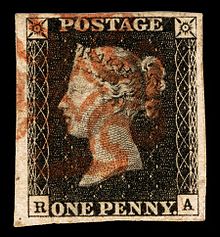 |
| Penny Black showing red cancellation mark |
Before 1840, mail correspondence was a complicated and costly affair. The postage was paid by the recipient, and was determined by the number of sheets mailed, and the distance it had to travel.
Roland Hill had worked out what he thought was a new, better plan for the British postal system, and explained it in his privately printed pamphlet, Post Office Reform: Its Importance and Practicability, which he published in 1837. The plan called for pre-paid postage and standardized and inexpensive rates. In 1839, Hill was given a 2-year contract to give his new plan a try, and in 1840, the new rates were put into use.
It was a smashing success. Inexpensive postage was rapidly becoming a necessity, as more and more sons and daughters were leaving the farm and village and moving to the cities to work in the new factories. Penny postage put correspondence within the reach of practically everyone.
The new system was so efficient that it was also an economic success. Under the previous system, each letter was logged by at the post office, a task that was unnecessary under the new system. The funds had to be collected when the letter was delivered, and the postman had to wait a minimum of 5 minutes at each household. Hill discovered that, under the old system, it took an hour and a half to deliver 67 letters. Under the new penny post, 570 letters could be delivered in a half hour. The distance that a letter had to travel was irrelevant to the cost of delivery -- almost all the expense was in the manpower necessary to log and deliver it. And, unfortunately, some individuals were too poor to accept delivery of the letter when it got to them.
The first postage stamp was called the Penny Black. It was printed in black ink, and bore a picture of Queen Victoria. The postmark was stamped in red ink when the letter was mailed. A Penny Black could mail a letter of up to a half ounce anywhere in England. Two days later, on May 8th, the Twopenny Blue was introduced, which could be used to mail a letter of up to one ounce. About a year later the Penny Black was replaced by the Penny Red, since it had been discovered that the red ink of the postmark was barely visible on the black stamp, making it possible for postage to be reused. None of these stamps were perforated -- the postal worker had to cut them apart with scissors, or tear them carefully. The idea of perforating them had been suggested to Hill, who decided that if the idea had been of any merit, it would have already been included in his pamphlet. The stamps were, however, self-adhesive.
Penny Blacks are valued by collectors because they were the first postage stamp and an important part of history, but they are not particularly rare. In part, this is because the practice of using envelopes was extremely rare at this time. The letters were folded, and the stamp affixed to the outside. If the letter was saved, the stamp was saved as well. A used Penny Black is worth about $200 today; an unused one is worth about $3,000.
As a reward for his services to England, Roland Hill was made a Knight Commander of the Order of the Bath. He also became a Fellow of the Royal Society and was given an honorary degree from Oxford University.
The Penny Black, Public Domain Image
No comments:
Post a Comment